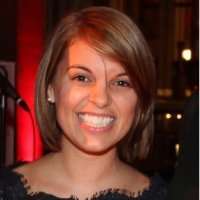Ambassadors of string quartet repertoire, La Catrina Quartet is a dynamic group of musicians. Performing music from Puerto Rico to Mexico to Argentina, La Catrina Quartet presented audiences with a fresh Mexican and Latin American sound.
La Catrina Quartet began Thursday night’s concert with Metro Chabacano by one of Mexico’s most prolific composer, Javier Álvarez. Named after one of the biggest and busiest metro stops in Mexico City, Metro Chabacano is immediately fast-paced and challenging to the ear. Starting out in unison, each player dropped out one by one to play an individual melody. What sounded like a piano phase was really a layering of sound. Performed with a high-level of technique and enthusiasm, La Catrina’s incessant playing drove the piece forward, transporting the audience out of the concert hall to the heart of a bustling metro stop.
Next, La Catrina Quartet performed the world première of Roberto Sierra’s Cuarteto para cuerdas No. 2. Commissioned by Symphony Space, La Catrina Quartet rehearsed this piece apart from Sierra, meeting the composer mere hours before the start of the show. In four movements, Sierra reconfigured popular dance-like rhythms that define traditional Puerto Rican music. Although each movement has a distinct theme—the first is a remodeled salsa, the second a nocturnal boléro, the third a wild scherzo and finally, a return to the transformed salsa—the piece is united by its experimentation with traditional rhythms and sounds. Throughout the piece, La Catrina Quartet attacked the complexities head-on to produce the new sound Sierra craves. The third movement was particularly challenging; written in a 3+2 meter, the dance-like rhythms of traditional Latin American music was most identifiable here, but its sheer wild and vivacious nature was distinctly fresh and new.
Of course, La Catrina Quartet did not ignore the influence of dance in traditional Latin American music. World renowned for his tango-inspired music, Piazzolla’s concert pieces are dramatic yet playful. In Tango Ballet, La Catrina Quartet captured the intensity of a tango perfectly; so much so, that the cello and violin transformed into a pair of dancers, intent on each other alone as the violin and viola played in counterpoint to their dramatic melodies. Executed perfectly, the only thing missing was a bandoneón. Similarly, in Manuel Ponce’s Intermezzo in E minor, La Catrina Quartet evoked images of a sultry Spanish square. A short piece, the quartet beckoned for romance with its sweet, swing-like rhythms and spirited tempo.
After the interval, La Catrina Quartet performed Joaquin Gutiérrez-Héras’ Cuarteto No. 1. Built upon one stone-like musical idea, it serves to frame the piece as well produce rhythmically charged themes. Here, the minimalist quality of the piece proved challenging but La Catrina Quartet adapted easily, performing with intensity but also a delicate touch for the lyrical sections of the piece.
While the majority of La Catrina Quartet’s programme aimed to create a distinctly new sound within Mexican and Latin American culture, Alberto Ginastera’s String Quartet No. 1, Op. 20 was openly nationalistic. Crafting musical themes to reflect the gauchos (cowboys) and rural dances in the Pampas (plains), String Quartet No. 1, Op. 20 served as a call to Argentinean nationalism. Although this was the end of the concert, La Catrina Quartet remained energetic throughout and performed brilliantly. From the aggressive, driving rhythms of the gauchos and the rural dance songs in the first and second movements to the beautiful, expressive colours in the Nocturne, La Catrina Quartet captured a breadth of tonal expression. They even executed unique cultural gems, such as open string guitar tuning, a curious technique that runs through many of Ginastera’s works, as well as strumming the strings like you would a guitar, which derives from Criolla folksong tradition.
While many musicians might feel exhausted at the end of such a high-energy concert, La Catrina Quartet looked like they were enjoying themselves immensely, smiling and engaging with the music. All together, Daniel Vega-Albela (violin), Blake Espy (violin), Jorge Martínez (viola) and César Martínez-Bourguet (cello) put on an infectious display of music virtuosity and an organic expression of their modern identity, culture and roots.
If you missed La Catrina Quartet Thursday night, there is still a chance to hear them live. Part of Symphony Space’s Wall to Wall Festival, Sonidos, La Catrina Quartet will perform Robert Sierra’s Cuarteto para cuerdas No. 2 on Saturday, alongside many other Latin American performers.


